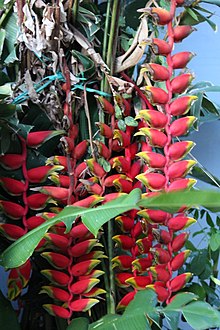Heliconia rostrata
| Heliconia rostrata | |
|---|---|

| |
| Lobster claws flower at peak season, Udumalpet, India | |
| Scientific classification | |
| Kingdom: | Plantae |
| Clade: | Tracheophytes |
| Clade: | Angiosperms |
| Clade: | Monocots |
| Clade: | Commelinids |
| Order: | Zingiberales |
| Family: | Heliconiaceae |
| Genus: | Heliconia |
| Species: | H. rostrata |
| Binomial name | |
| Heliconia rostrata Ruiz & Pavon | |
| Synonyms[1] | |
| |
Heliconia rostrata, the hanging lobster claw or false bird of paradise, is a herbaceous perennial plant native to El Salvador, Peru, Bolivia, Colombia, Venezuela, Costa Rica, and Ecuador, and naturalized in Puerto Rico.[2] The inflorescences of many other heliconias grow vertically, facing upwards (e.g. Heliconia bihai), their cup-shaped bracts storing water for birds and insects. This plant, however, has pendulous inflorescences with the bracts facing downwards, the flowers nestled underneath. Without the collection of rainwater in the bracts, the flowers within them provide a source of undiluted nectar.[3][4]
Heliconias are known to those who grow them as a host flower to many birds, especially hummingbirds. Because of its unique characteristics, it is often used as a specimen for tropical gardens.
Along with the cantuta flower, Heliconia rostrata, known as patujú, is the national flower of Bolivia.
Gallery
See also
References
- ^ The Plant List, Heliconia rostrata
- ^ Kew World Checklist of Selected Plant Families, Heliconia rostrata[permanent dead link]
- ^ Ruiz López, Hipólito & Pavón, José Antonio. 1802. Flora Peruviana, et Chilensis 3: 71, t. 305, Heliconia rostrata
- ^ Brako, L. & J. L. Zarucchi. (eds.) 1993. Catalogue of the Flowering Plants and Gymnosperms of Peru. Monographs in systematic botany from the Missouri Botanical Garden 45: i–xl, 1–1286.
External links

